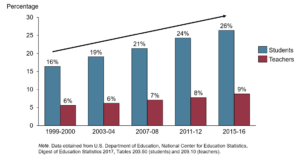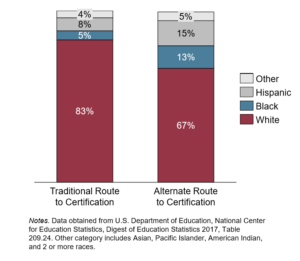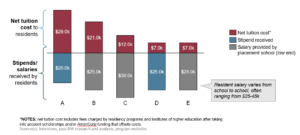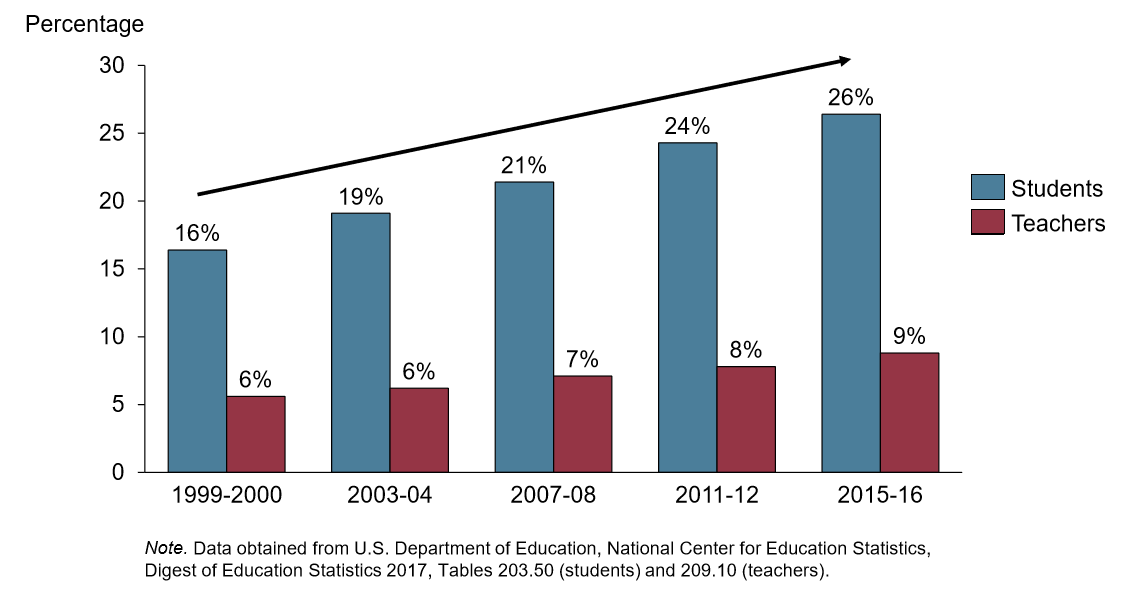A growing number of studies have documented the benefits of teacher diversity, as my colleagues have previously discussed (see here and here). And research drawing on data from the Measures of Effective Teaching project found that all students preferred teachers of color. Yet despite the value of diversifying the teaching workforce, Black teachers remain underrepresented. They made up around 7 to 8 percent of all teachers between school years 1999-2000 and 2015-2016, while Black students accounted for between 16 to 17 percent of all students in the same time period. The proportion of Hispanic public elementary and secondary school teachers appeared to be increasing slightly, but not nearly as fast as the proportion of Hispanic students, as seen in the figure below.

As my colleague Katrina has noted, a number of barriers to diversifying the teacher workforce exist, including the considerable cost to become a teacher. Traditional preparation programs have high out-of-pocket and opportunity costs (i.e., limited income while enrolled in a program). As Ashley LiBetti and Justin Trinidad describe in their recent report, these costs limit the pool of teacher candidates:
In the traditional model, candidates must invest more than $24,000 and 1,500 hours to become a teacher…This upfront financial and opportunity cost limits the pool of candidates to those who can afford the risk, effectively cutting out nontraditional candidates, low- and lower-middle-income candidates, and career-changers.
Given well-documented racial disparities in wealth, the high cost of becoming a teacher is likely to have a disproportionate impact on the career decisions of people of color. Alternate routes to teaching may be an attractive option for prospective teachers who are sensitive to costs. As seen below, teachers from alternate routes tend to be more racially diverse than teachers from traditional teacher preparation programs.

Yet alternate routes have proven controversial, even when evidence suggests that alternatively certified teachers are equally or more effective at increasing student achievement on standardized tests, relative to their counterparts. In Houston, for example, school district trustees recently voted to end the district’s contract with Teach For America, citing concerns about teacher turnover.
Teacher residency programs have emerged as perhaps a more politically viable alternative certification route than “fast-track” programs, by emphasizing on-the-job training prior to becoming a teacher of record. Because residents are typically paid a stipend during their apprenticeship period, entering teaching through a residency tends to cost less than entering through a traditional route. However, residencies typically pay a stipend that is less than what a teacher of record would earn. As a result, the cost of entering the profession through a residency program is higher than the cost of entering through a fast-track alternative certification program.
Other costs associated with entering teaching through a residency program include tuition and related fees. Such costs may be subsidized through AmeriCorps or other funding mechanisms. Due to differences in tuition amounts and subsidies, these additional costs of becoming a teacher through a residency program vary from about $7,000 to nearly $30,0000.

Because the district typically pays the stipend or salary to the resident while also paying the teacher of record, the cost to the district of recruiting teachers through a residency is likely greater than the cost of recruiting teachers from traditional or fast-track alternative certification programs. But to the extent that graduates of residency programs have higher retention rates, the additional expense may be offset by reductions in future recruitment costs. Further, residencies afford districts more control over the teacher pipeline, may be targeted to areas that have traditionally been shortage areas, and can provide more diverse teacher candidates for these shortage areas.
If we want diverse teachers with an abundance of on-the-job training, residencies are a very promising model. Residencies don’t necessarily reduce costs to produce a teacher, but they do tend to redistribute those costs. In doing so, they are able to recruit a more diverse set of teacher candidates, fill vacancies, and improve retention.
This blog post is part of a series on teacher residencies. Read the other posts in the #ResidentExperts series here.
